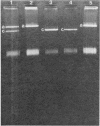Abstract
Virulent and certain avirulent strains of Bacillus anthracis harbor a plasmid, designated pXO2, which is involved in the synthesis of capsules. Two classes of rough, noncapsulated (Cap-) variants were isolated from the capsule-producing (Cap+) Pasteur vaccine strains ATCC 6602 and ATCC 4229. One class was cured of pXO2, and the other class still carried it. Reversion to Cap+ was demonstrable only in rough variants which had retained pXO2. Proof that pXO2 is involved in capsule synthesis came from experiments in which the plasmid was transferred by CP-51-mediated transduction and by a mating system in which plasmid transfer is mediated by a Bacillus thuringiensis fertility plasmid, pXO12. Cells of Bacillus cereus and a previously noncapsulated (pXO2-) strain of B. anthracis produced capsules after the acquisition of pXO2.
Full text
PDF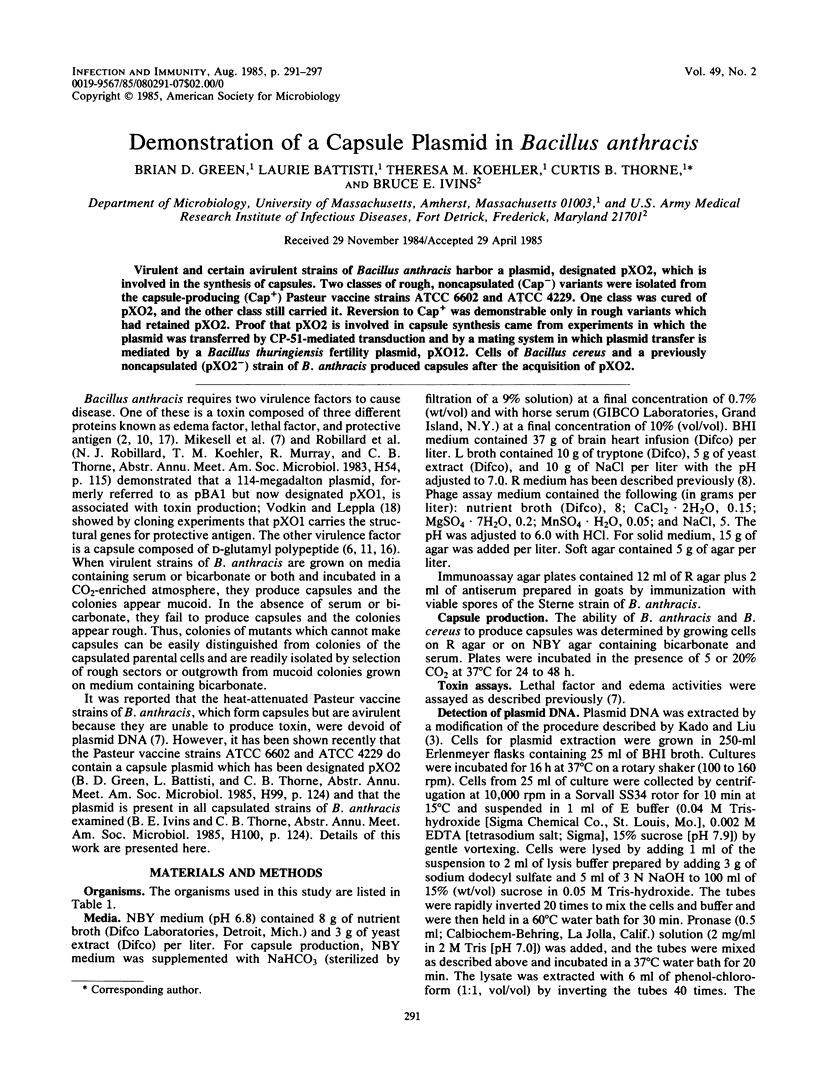

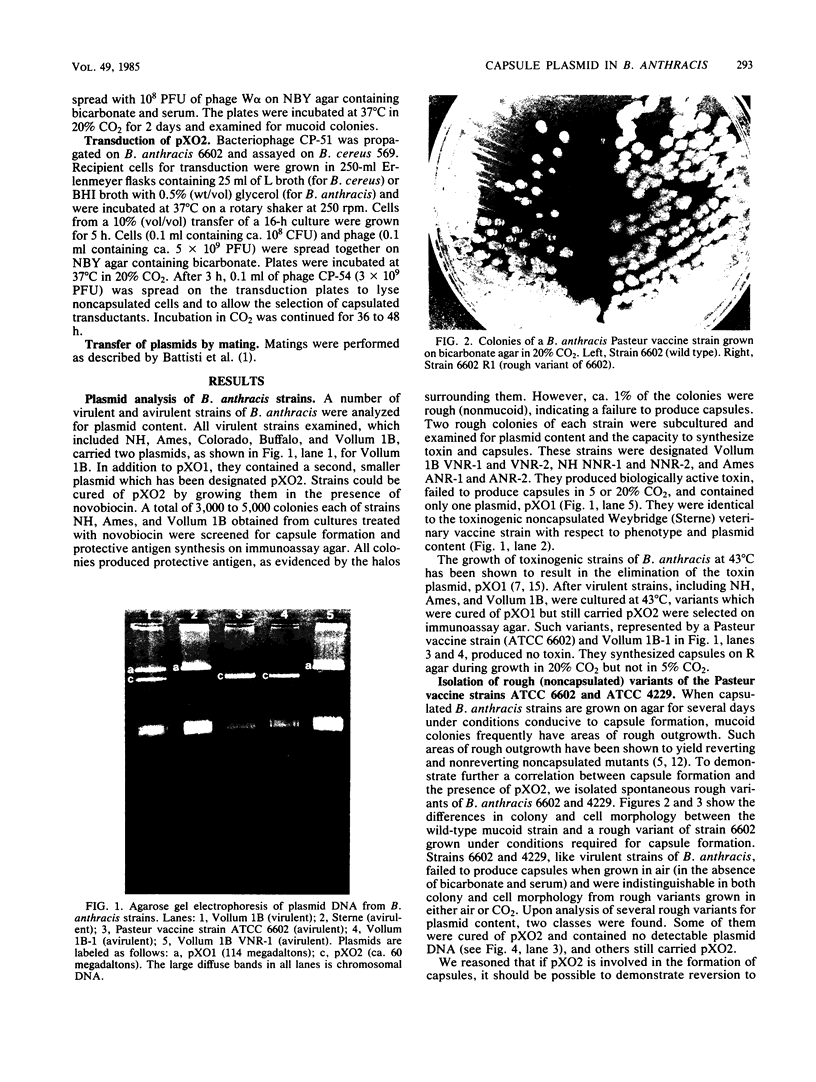
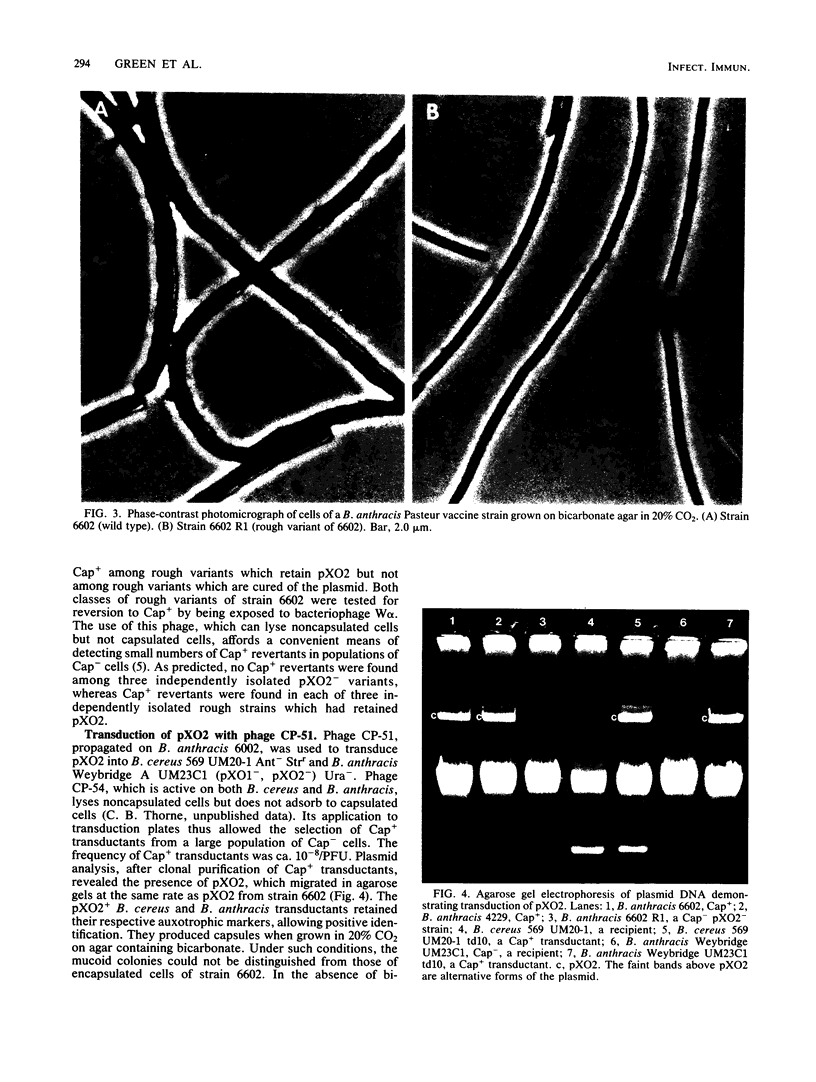
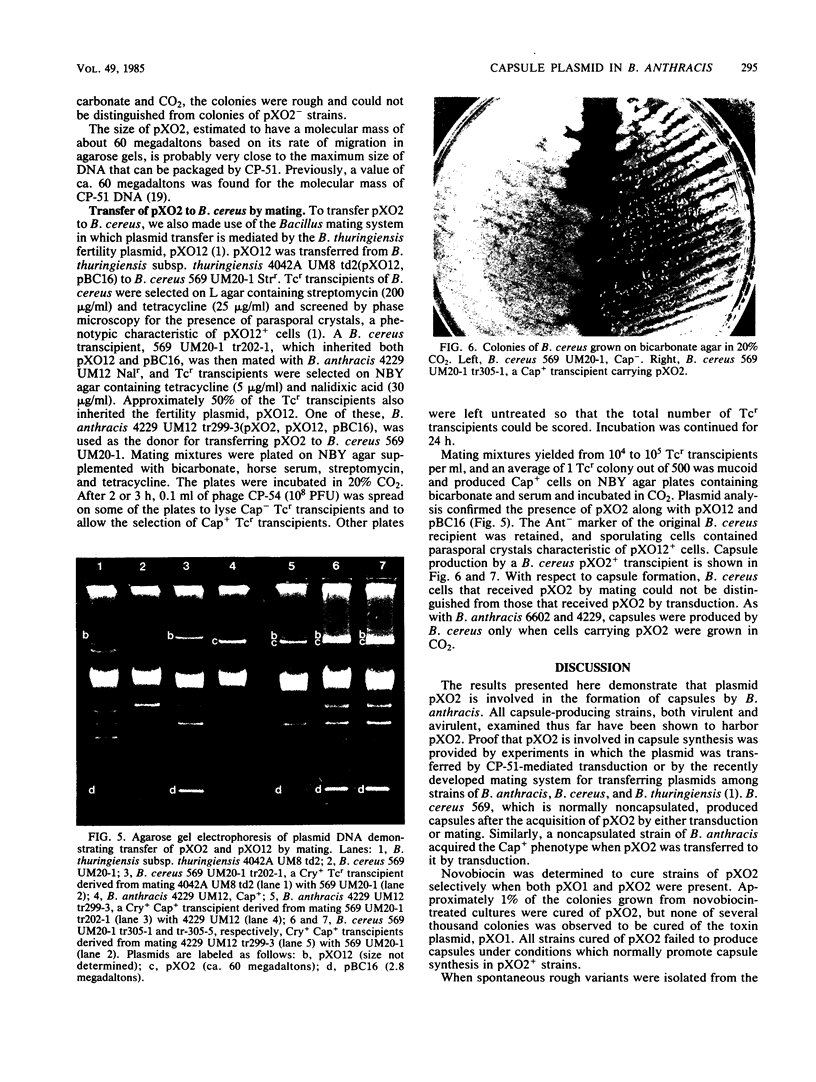
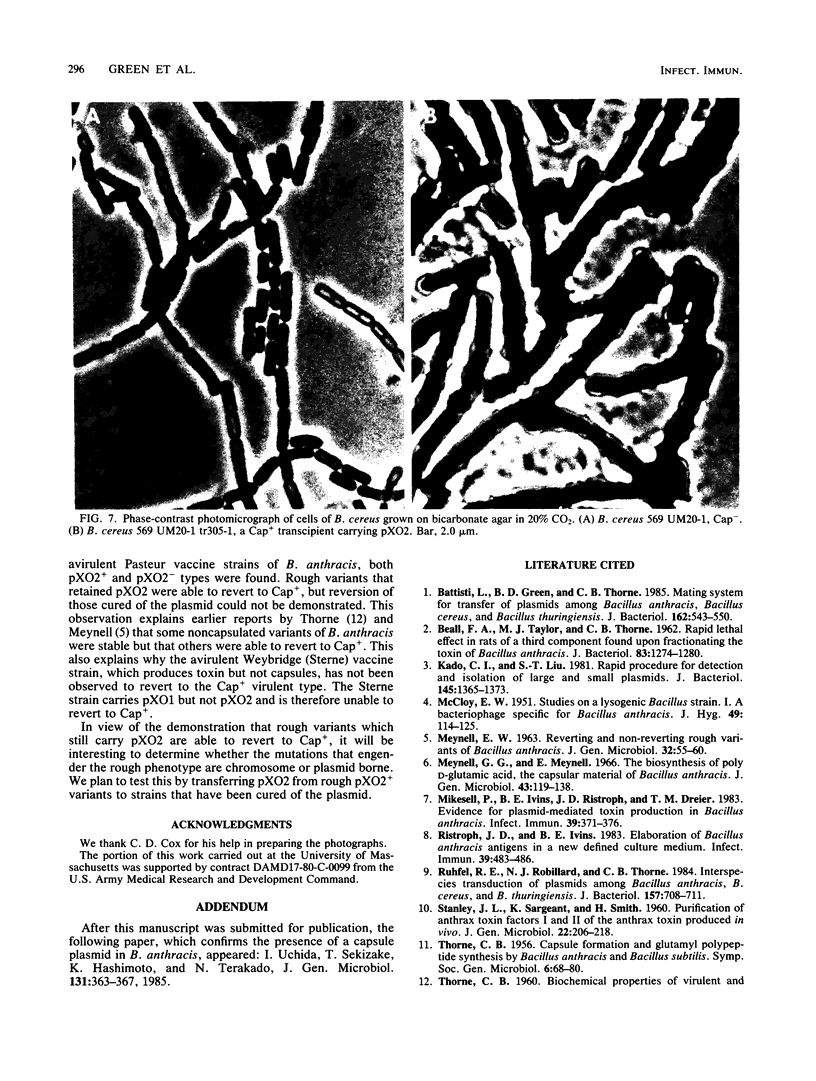
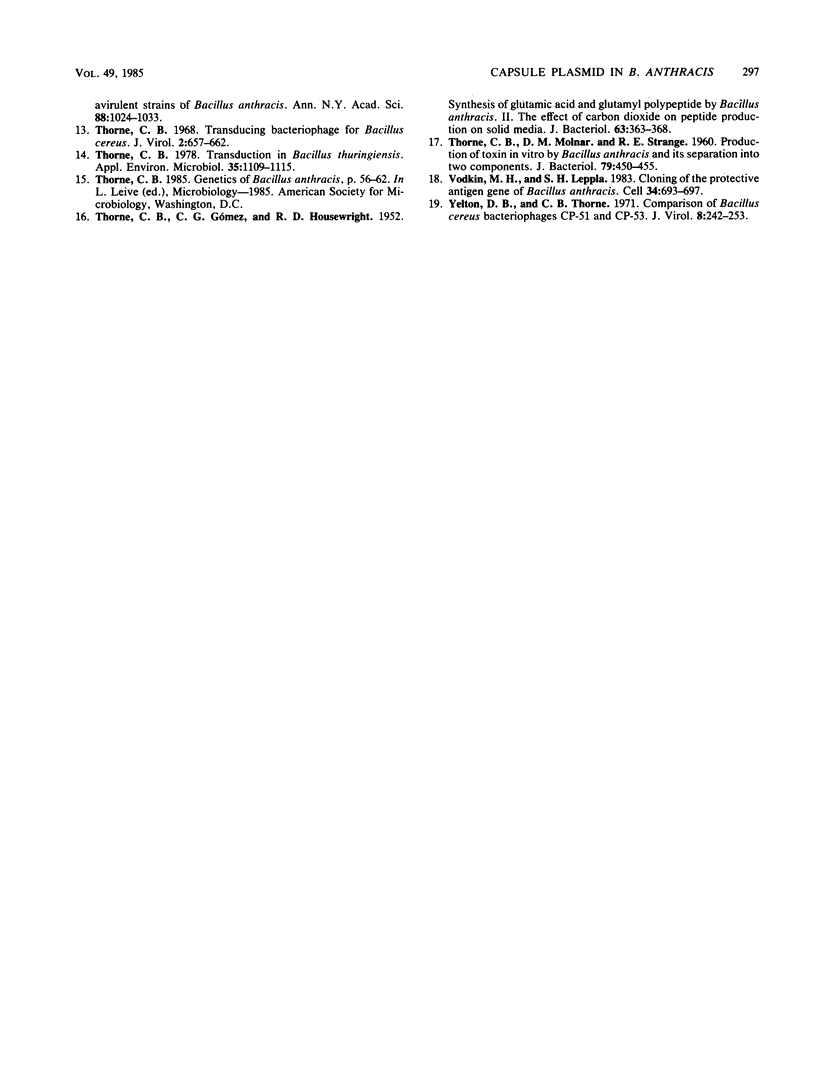
Images in this article
Selected References
These references are in PubMed. This may not be the complete list of references from this article.
- BEALL F. A., TAYLOR M. J., THORNE C. B. Rapid lethal effect in rats of a third component found upon fractionating the toxin of Bacillus anthracis. J Bacteriol. 1962 Jun;83:1274–1280. doi: 10.1128/jb.83.6.1274-1280.1962. [DOI] [PMC free article] [PubMed] [Google Scholar]
- Battisti L., Green B. D., Thorne C. B. Mating system for transfer of plasmids among Bacillus anthracis, Bacillus cereus, and Bacillus thuringiensis. J Bacteriol. 1985 May;162(2):543–550. doi: 10.1128/jb.162.2.543-550.1985. [DOI] [PMC free article] [PubMed] [Google Scholar]
- Kado C. I., Liu S. T. Rapid procedure for detection and isolation of large and small plasmids. J Bacteriol. 1981 Mar;145(3):1365–1373. doi: 10.1128/jb.145.3.1365-1373.1981. [DOI] [PMC free article] [PubMed] [Google Scholar]
- MEYNELL E. W. REVERTING AND NON-REVERTING ROUGH VARIANTS OF BACILLUS ANTHRACIS. J Gen Microbiol. 1963 Jul;32:55–60. doi: 10.1099/00221287-32-1-55. [DOI] [PubMed] [Google Scholar]
- Meynell G. G., Meynell E. The biosynthesis of poly d-glutamic acid, the capsular material of Bacillus anthracis. J Gen Microbiol. 1966 Apr;43(1):119–138. doi: 10.1099/00221287-43-1-119. [DOI] [PubMed] [Google Scholar]
- Mikesell P., Ivins B. E., Ristroph J. D., Dreier T. M. Evidence for plasmid-mediated toxin production in Bacillus anthracis. Infect Immun. 1983 Jan;39(1):371–376. doi: 10.1128/iai.39.1.371-376.1983. [DOI] [PMC free article] [PubMed] [Google Scholar]
- Ristroph J. D., Ivins B. E. Elaboration of Bacillus anthracis antigens in a new, defined culture medium. Infect Immun. 1983 Jan;39(1):483–486. doi: 10.1128/iai.39.1.483-486.1983. [DOI] [PMC free article] [PubMed] [Google Scholar]
- Ruhfel R. E., Robillard N. J., Thorne C. B. Interspecies transduction of plasmids among Bacillus anthracis, B. cereus, and B. thuringiensis. J Bacteriol. 1984 Mar;157(3):708–711. doi: 10.1128/jb.157.3.708-711.1984. [DOI] [PMC free article] [PubMed] [Google Scholar]
- STANLEY J. L., SARGEANT K., SMITH H. Purification of factors I and II of the anthrax toxin produced in vivo. J Gen Microbiol. 1960 Feb;22:206–218. doi: 10.1099/00221287-22-1-206. [DOI] [PubMed] [Google Scholar]
- THORNE C. B. Biochemical properties of virulent and avirulent strains of Bacillus anthracis. Ann N Y Acad Sci. 1960 Nov 21;88:1024–1033. doi: 10.1111/j.1749-6632.1960.tb20094.x. [DOI] [PubMed] [Google Scholar]
- THORNE C. B., GOMEZ C. G., HOUSEWRIGHT R. D. Synthesis of glutamic acid and glutamyl polypeptide by Bacillus anthracis. II. The effect of carbon dioxide on peptide production on solid media. J Bacteriol. 1952 Mar;63(3):363–368. doi: 10.1128/jb.63.3.363-368.1952. [DOI] [PMC free article] [PubMed] [Google Scholar]
- THORNE C. B., MOLNAR D. M., STRANGE R. E. Production of toxin in vitro by Bacillus anthracis and its spearation into two components. J Bacteriol. 1960 Mar;79:450–455. doi: 10.1128/jb.79.3.450-455.1960. [DOI] [PMC free article] [PubMed] [Google Scholar]
- Thorne C. B. Transducing bacteriophage for Bacillus cereus. J Virol. 1968 Jul;2(7):657–662. doi: 10.1128/jvi.2.7.657-662.1968. [DOI] [PMC free article] [PubMed] [Google Scholar]
- Thorne C. B. Transduction in Bacillus thuringiensis. Appl Environ Microbiol. 1978 Jun;35(6):1109–1115. doi: 10.1128/aem.35.6.1109-1115.1978. [DOI] [PMC free article] [PubMed] [Google Scholar]
- Uchida I., Sekizaki T., Hashimoto K., Terakado N. Association of the encapsulation of Bacillus anthracis with a 60 megadalton plasmid. J Gen Microbiol. 1985 Feb;131(2):363–367. doi: 10.1099/00221287-131-2-363. [DOI] [PubMed] [Google Scholar]
- Vodkin M. H., Leppla S. H. Cloning of the protective antigen gene of Bacillus anthracis. Cell. 1983 Sep;34(2):693–697. doi: 10.1016/0092-8674(83)90402-6. [DOI] [PubMed] [Google Scholar]
- Yelton D. B., Thorne C. B. Comparison of Bacillus cereus bacteriophages CP-51 and CP-53. J Virol. 1971 Aug;8(2):242–253. doi: 10.1128/jvi.8.2.242-253.1971. [DOI] [PMC free article] [PubMed] [Google Scholar]




